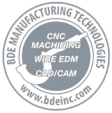Posted On: September 20, 2019
3D printing is projected as one of the future-oriented technologies. When it was first introduced, there were apprehensions that it will replace CNC machining services completely. However, that is yet to happen, and both technologies are being used simultaneously across industries, owing to distinct advantages offered by them. Do you want to know why these technologies are in demand? Read the post to know more.
An Overview of 3D Printing and CNC Machining
It is important to understand the underlying processes of these machining techniques before proceeding to their advantages.
- CNC Machining:
Computer Numerical Control machining is a subtractive machining technique, where the material is carved out of a large sheet to create desired part shapes in precise dimensions.
- 3D Printing:
This is an additive manufacturing technique, where a material is built up by adding a layer of material at a time.
A Few Points of Differences Between 3D Printing and CNC Machining
After understanding the basics of these machining techniques, the following points will help you understand the key differences between these technologies.
- Materials:
CNC machines are designed to accept a wide variety of materials such as metal alloys including copper, brass, aluminum, steel alloys, and so on. These machines are also suited for machining wax, modeling foams, and various types of thermoplastic materials. You will require different types of cutting tools to machine these materials; still, they can be molded into desired shapes easily.
Desktop 3D printers have certain limitations when it comes to materials. They are designed for machining resins and thermoplastics, whereas some are also designed for machining metals. 3D printing is not preferred for regular workable metals such as stainless steel and aluminum because it requires expensive machines, whereas CNC machining can be easily done at much lower costs. 3D printing is considered ideal for superalloys, which are otherwise difficult to machine using CNC machines.
- Ease of Implementation:
Although both these techniques are computer-controlled, there are huge differences in their implementation. For instance, in 3D printing, once the file is created, one needs to choose the fill, part orientation, and support, as required. No supervision is required during the whole process. Against this, the CNC machining requires regular intervention from a skilled machinist at regular intervals in terms of changing the rotational speed of tools, the material repositioning, and choice of tools.
- Repeatability:
A CNC machine can be programmed to machine a product, in the same way, every time. However, this is not possible with 3D printing.
- Part Sizes:
CNC machining is suited for making a broad range of equipment parts ranging from the tiniest part to the largest part such as of refrigerators or washing machines. However, the part sizes are limited in 3D printing. To produce a large-sized part, the components are first broken into small sizes, and then finally assembled. This final assembly adds to the production time.
- Speed:
This is a key difference between these two technologies. CNC machining is considered ideal for mass production of products because it utilizes a broad set of machines for different tasks during the production. The 3D printer is single equipment, which performs entire machining from start to finish, which makes it time-consuming at many times.
Like any other technology, 3D printing and CNC machining offer several advantages and disadvantages. Thus, the choice of the right technology will depend on your requirements. If you are looking for a CNC machining shop for your next project, you must partner with a trusted service provider like BDE, Inc., which is a quick turnaround machine shop in Portland, Oregon. The company has been providing CNC machining services to its clients in aerospace, medical, military, oil and gas, architectural, energy, and marine industries for several years now.
Related Blog Post:
CNC Machining: Best Techniques for You
Why are 4 Axis CNC Machines Preferred over Other Types?
 info@bdeinc.com
info@bdeinc.com 866.262.6233
866.262.6233





